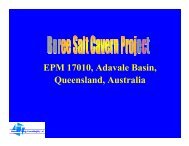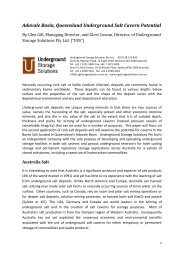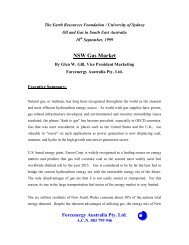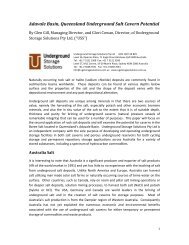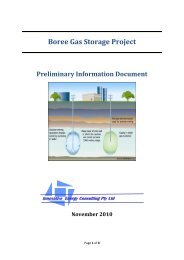Natural gas storage in salt caverns present trends in Europe
Natural gas storage in salt caverns present trends in Europe
Natural gas storage in salt caverns present trends in Europe
Create successful ePaper yourself
Turn your PDF publications into a flip-book with our unique Google optimized e-Paper software.
well head temperature / deg C<br />
GILLHAUS, A. (2007): <strong>Natural</strong> <strong>gas</strong> <strong>storage</strong> <strong>in</strong> <strong>salt</strong> <strong>caverns</strong> – Present status, developments and future <strong>trends</strong> <strong>in</strong> <strong>Europe</strong><br />
35<br />
30<br />
25<br />
20<br />
15<br />
10<br />
5<br />
0<br />
withdrawal<br />
Figure 9: Gas temperature at wellhead versus time.<br />
This problem can be solved by conduct<strong>in</strong>g numerical simulations of the thermodynamic<br />
conditions based on large amounts of empirical data on comparable operations.<br />
5.3 Drill<strong>in</strong>g and completion<br />
The <strong>present</strong> maximum diameter of the <strong>gas</strong> production str<strong>in</strong>g (9-5/8“) currently limits the<br />
withdrawal and <strong>in</strong>jection rates as well as the withdrawal duration. This size is necessitated<br />
by the maximum 9-5/8“ diameter of the subsurface safety valve (SSSV) stipulated by the<br />
authorities <strong>in</strong> <strong>Europe</strong>.<br />
Production str<strong>in</strong>gs with larger diameters of up to 18 5/8” are standard <strong>in</strong> the USA where no<br />
SSSVs are stipulated.<br />
Use is therefore made <strong>in</strong> Germany of monobore completions to achieve the maximum<br />
possible cross-section us<strong>in</strong>g the stipulated 9-5/8“ diameter and thus achieve the highest<br />
possible withdrawal and <strong>in</strong>jection rates under these conditions. The first <strong>gas</strong> cavern<br />
project to be realised <strong>in</strong> the Netherlands will also be the first to <strong>in</strong>crease the flow cross-<br />
section of the production and <strong>in</strong>jection str<strong>in</strong>gs by <strong>in</strong>stall<strong>in</strong>g a tw<strong>in</strong> borehole (Fig. 10).<br />
5.4 Modus operandi<br />
<strong>gas</strong> hydrate formation temperature for<br />
North Sea <strong>gas</strong><br />
Russian <strong>gas</strong><br />
standstill<br />
0 10 20 30 40 50<br />
time / days<br />
Opposite to <strong>gas</strong> <strong>caverns</strong> liquid product <strong>caverns</strong> are operated under constant pressure: this<br />
is done by displac<strong>in</strong>g the br<strong>in</strong>e <strong>in</strong>to a surface br<strong>in</strong>e shuttle pond dur<strong>in</strong>g the <strong>in</strong>jection of the<br />
product from where the br<strong>in</strong>e is re<strong>in</strong>jected <strong>in</strong>to the cavern to displace the liquid dur<strong>in</strong>g<br />
page 15 of 18<br />
Q = 100 000 m³/h<br />
75 000 m³/h<br />
50 000 m³/h<br />
25 000 m³/h





